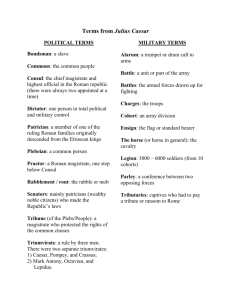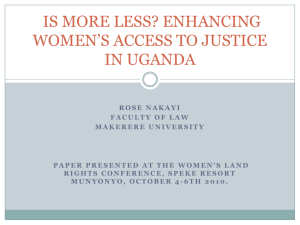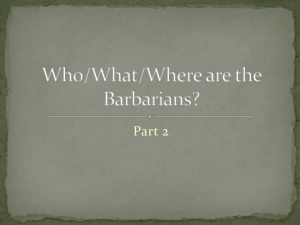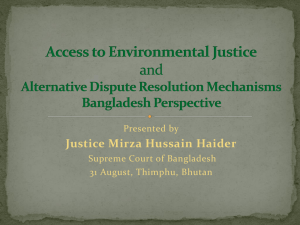sources of law.
advertisement
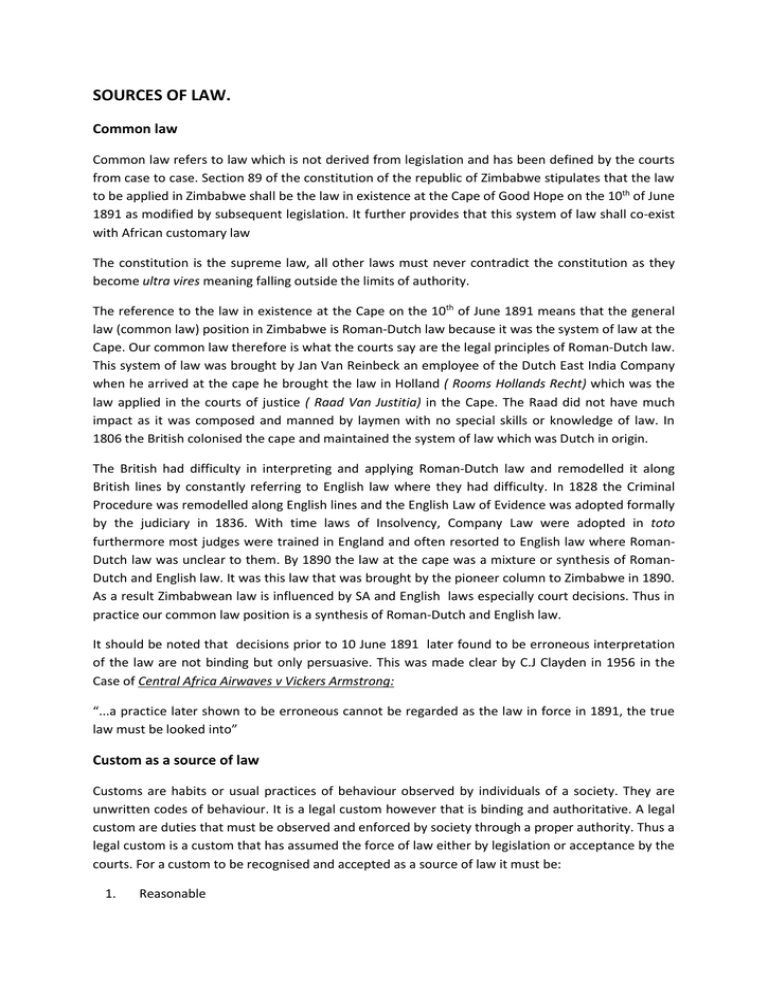
SOURCES OF LAW. Common law Common law refers to law which is not derived from legislation and has been defined by the courts from case to case. Section 89 of the constitution of the republic of Zimbabwe stipulates that the law to be applied in Zimbabwe shall be the law in existence at the Cape of Good Hope on the 10th of June 1891 as modified by subsequent legislation. It further provides that this system of law shall co-exist with African customary law The constitution is the supreme law, all other laws must never contradict the constitution as they become ultra vires meaning falling outside the limits of authority. The reference to the law in existence at the Cape on the 10th of June 1891 means that the general law (common law) position in Zimbabwe is Roman-Dutch law because it was the system of law at the Cape. Our common law therefore is what the courts say are the legal principles of Roman-Dutch law. This system of law was brought by Jan Van Reinbeck an employee of the Dutch East India Company when he arrived at the cape he brought the law in Holland ( Rooms Hollands Recht) which was the law applied in the courts of justice ( Raad Van Justitia) in the Cape. The Raad did not have much impact as it was composed and manned by laymen with no special skills or knowledge of law. In 1806 the British colonised the cape and maintained the system of law which was Dutch in origin. The British had difficulty in interpreting and applying Roman-Dutch law and remodelled it along British lines by constantly referring to English law where they had difficulty. In 1828 the Criminal Procedure was remodelled along English lines and the English Law of Evidence was adopted formally by the judiciary in 1836. With time laws of Insolvency, Company Law were adopted in toto furthermore most judges were trained in England and often resorted to English law where RomanDutch law was unclear to them. By 1890 the law at the cape was a mixture or synthesis of RomanDutch and English law. It was this law that was brought by the pioneer column to Zimbabwe in 1890. As a result Zimbabwean law is influenced by SA and English laws especially court decisions. Thus in practice our common law position is a synthesis of Roman-Dutch and English law. It should be noted that decisions prior to 10 June 1891 later found to be erroneous interpretation of the law are not binding but only persuasive. This was made clear by C.J Clayden in 1956 in the Case of Central Africa Airwaves v Vickers Armstrong: “...a practice later shown to be erroneous cannot be regarded as the law in force in 1891, the true law must be looked into” Custom as a source of law Customs are habits or usual practices of behaviour observed by individuals of a society. They are unwritten codes of behaviour. It is a legal custom however that is binding and authoritative. A legal custom are duties that must be observed and enforced by society through a proper authority. Thus a legal custom is a custom that has assumed the force of law either by legislation or acceptance by the courts. For a custom to be recognised and accepted as a source of law it must be: 1. Reasonable 2. 3. 4. Certain, clear and consistent with statute law Uniformly observed Long established These requirements were laid down in the famous case Van Breda v Jacobs (1921): there was a custom among fishermen at the Cape Point, in terms of the custom once a party of fishermen had commenced, netting a shoal f fish between the Cape and Fishoek no other group of fishermen could target the same shoal. The custom was known as “first come first pull”. A group of fishermen (Jacobs) broke the custom and the matter ended up before the courts. The courts had decide whether the custom had become law (legally binding) the court proceeded to lay down the requirements which must be met before a custom can become law as follows: i. ii. iii. iv. The custom must be reasonable in this case it was found to be since it prevented disputes The custom must be long established, in this case it was practiced for 45 years and it was accepted It must be uniformly observed, known by all fisher man in the cape It must be clear and consistent with statute law of which this custom was The plaintiff showed all these elements to be present in the “first come first pull” custom The court came to the conclusion that the custom had become law and the defendant was found liable and ordered to pay the value of the catch they had intercepted in violation of the custom. Case law/judicial precedent This is also known as judge made law. A precedent is a previous judicial decision which serves as a rule or guide for similar cases to be heard in future i.e. once a court has given a ruling concerning the legal position applicable in a particular set of circumstances this ruling becomes the law for the future. Other courts will thereafter apply the law as stated in the original case Key concepts of case law 1. 2. 3. 4. Doctrine of stare decisis Ratio decidendi Obita dicta Hierarchy of courts Doctrine of stare decisis This is known in full as the doctrine of stare decisis et non quita movere which means stand by the decision and do not disturb settled points. Once a court reaches a decision or gives a ruling that court and those inferior/subordinate to it are to give the same decision on similar cases with similar facts to be heard in future. The doctrine is in keeping with the hierarchy of courts. Under this, the decisions of the supreme court and High court are binding on all other court but not themselves. The Supreme court is not bound by its decision. The doctrine is of benefit in that it ensures uniformity, certainty, and is predictable, saves time and keeps the weak judge in line. The doctrine may however perpetuate bad law and is often criticised for failing to cope with changes in time and sentiments. Ratio decidendi It means reasons for the decision or material facts of the case plus the decision thereon. Under the doctrine of stare decisis a court is obliged to follow the decision of a superior court, here it is the actual principles of the decision. In arriving at a decision a court takes into account a number of aspects e.g. credibility of witness etc in addition to the material facts. The sum total of the material used in reaching a decision is what is called ratio decidendi. In Collet v Priest Lord Devilliers remarked that: “...whatever the reasons for the decision maybe, it is the legal principle to be extracted from the case which is binding and not necessarily the reasons given for it.” Ratio decidendi is therefore the basis for the court’s decision i.e. the legal principle which led to the conclusion arrived at. Obita dicta These are incidental or by the way statement made in passing to central issues of the case. Such statements are only persuasive and not necessarily binding. This doctrine was perfectly enunciated in the cases of Jajbhay v Cassim (1939) and Peterson v Jajbhay (1940). LEGISLATION This is law made by parliament or any other competent authority. To this end parliament is sometimes referred to as the legislature and the laws it makes are called Acts of parliament or statutes. Statutes override all other laws that may be inconsistent with its provisions. Although it is the duty of parliament to pass laws, it can delegate part of its authority to other subsidiary bodies like local authorities ( municipalities) or parastatals the resulting laws are known as delegated legislation Group Assignment (February to June 2010) 1. Discuss in detail, the legislative process in Zimbabwe, outlining what happens at each stage. [20] OR 2. (a) Discuss the structure and jurisdiction of Zimbabwe’s courts of first instance (b) distinguish between authoritative and persuasive sources of law [15] [5] HIERARCHY OF COURTS The Zimbabwe court structure is in keeping with the doctrine of stare decisis. Village court. It is the lowest court in Zimbabwe and relies on customary law. It is established by the Customary Law & Local Courts Act. It is presided by the Headman. It does not have criminal law jurisdiction only civil law jurisdiction where customary law is applied and i. ii. iii. Defendant must be resident in area of jurisdiction Cause of action arose within that area The defendant consents to the court’s jurisdiction Procedures are informal and local language is used, court must keep a record of names of parties, nature of dispute and the judgement. There is no legal representation and deals with minor issues/disputes e.g. where one’s livestock stray into the field of a fellow villager. Chief’s court It is also created by the customary law & local courts act. It is presided over by the chief. It is a court of first instance and appeal, it hears appeals from the village court. It applies customary law only, informal procedures, it is specifically prohibited from handling cases of divorce, child custody and maintenance. Appeals from this court lie with the magistrate’s court customary law. Community court It keeps formal records of proceedings and are presided over by a judicial officer known as a presiding officer assisted by assessors if he so wishes. These judicial officers are appointed from the Ministry of Justice with the n qualifications. They have limited criminal jurisdiction, and tries crimes of theft, assault without causing grievous bodily harm, property damage. Small claims court Established by the Small Claims Court Act of 1992. It is currently based in Harare and Bulawayo. It is presided over by a magistrate, semi formal procedures with no legal representation. The high court has power to review the court’s decision where allegations of gross irregularities are cited in proceedings e.g. magistrate had interest in the case. It is designed for speedy settlement of disputes hence no pleadings Magistrate’s Court Magistrate’s Court- Customary Law It is a court of appeal and first instance and it applies customary law only. A magistrate presides over it, it is a court of record and allows legal representation. It handles cases like divorce, division of property, custody and maintenance Appeals must be lodged with the district court. Magistrate’s court – civil law In all civil cases, the jurisdiction of all magistrate is the same irrespective of rank Handle claims of unpaid debts, contractual disputes Allows legal representation Court of formal proceedings Appeals lie with the high court Magistrate’s court- criminal court Jurisdiction depends on rank of magistrate. These magistrates are headed by a chief justice whose function is mainly administrative, they can try any crime except treason, murder or those requiring a death sentence Ordinary magistrate can impose a term of imprisonment up to 1 year Senior magistrate can impose a term of imprisonment of up to 2 years Provincial magistrate can impose a term of imprisonment of up to 3 years Regional magistrate can impose a term of imprisonment of up to 7 years In rape cases they can impose a maximum of 10 years. In addition all magistrates are granted certain powers by some acts e.g. Fire Arms Act, Stock Theft Act, to impose a certain minimum years on each count. All magistrates can order whipping of juveniles, community services usually for first offenders. Appeals from the magistrate’s court depend on the nature of the appeal i.e. if it is against sentence it lies with the high court but if it is against both conviction and sentence it lies with the supreme court. High court It is a creation of the constitution, it is headed by a judge president. The high court is permanently based in Harare and Bulawayo but moves in circuit or sits periodically in Gweru, Hwange, Masvingo and Mutare. It applies customary, civil and criminal law and has no limits to its jurisdiction Can pass the death sentence Both court of appeal and first instance in the case of treason Highly formal and the majority of litigance are legally represented Handles divorce where parties are married in terms of the Marriages Act Supreme Court It is the highest court in Zimbabwe and permanently in Harare but periodically sits in Bulawayo. It is headed by a chief justice who is head of the entire judiciary It is essentially a court of appeal but of first instance when sitting as a constitutional court i.e. where a person alleges a violation of his fundamental constitutional right e.g. freedom of association. When sitting as a constitutional court all 5 chief justices must be present No appeal against a supreme court decision only the President in the exercise of his prerogative powers can pardon or grant amnesty to accused or convicted A pardon can only be considered after appeal process is exhausted. Even if pardon is granted the person remains convicted but pardoned NB: Apart from the mainstream courts there are other specialised ones which include the Labour Court, disciplinary bodies (army) and the administrative court.

